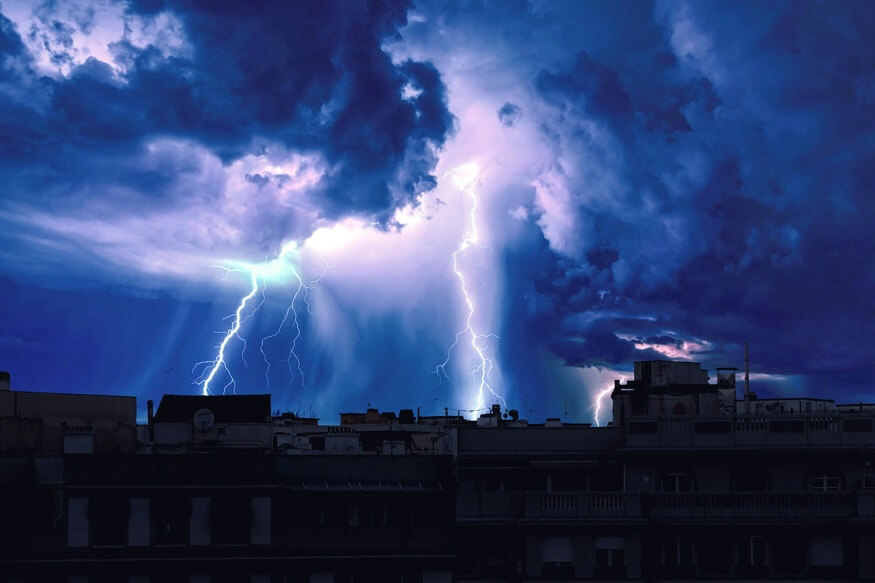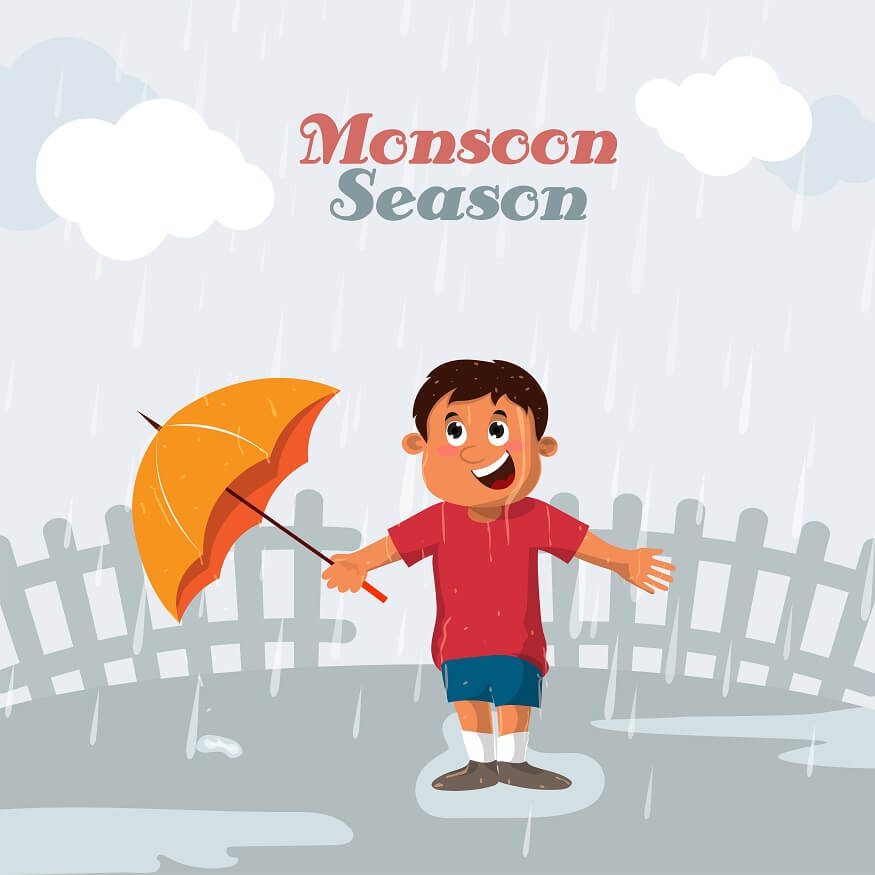Lightning is a natural atmospheric electrical discharge that occurs during thunderstorms. The build-up and release of electrical energy within the atmosphere during thunderstorms lead to lightning and it is a natural atmospheric electrical discharge. This phenomenon is governed by various contributing factors influencing its emergence. In this article, you will read about some lightning safety tips and safety precautions during lightning and thunderstorms.
Also Read: 10 Safety Rules at School You Must Teach Your Children
Causes of Lightning
Here are the main factors that contribute to the occurrence of lightning:
- Atmospheric Conditions
- Charge Separation
- Electrical Potential
- Electrical Discharge
- Lightning Strike
Thunderstorms are known for causing lightning to arise under particular weather conditions at work simultaneously. In particular, warm humid air rises very quickly from lower altitudes into higher colder atmospheric layers. As a result of this accelerated motion forceful updrafts and downdrafts materialise inspiring the eventual formation of storm clouds bearing electrical discharge capabilities also known as thundershowers.
Within a thundercloud, there is a separation of positive and negative charges. This charge separation occurs due to the movement of water droplets, ice particles, and graupel (soft hail) within the cloud. The lighter ice particles and graupel rise to the upper part of the cloud, carrying positive charges, while heavier raindrops and ice crystals descend, carrying negative charges.
As the charge separation intensifies within the thundercloud, a significant electrical potential difference builds up between the positively charged upper region of the cloud and the negatively charged lower region.
When the electrical potential difference becomes large enough to overcome the insulating properties of the air, a conductive path is created. This conductive path is formed by a stepped leader, a channel of ionised air that descends from the cloud toward the ground in a series of steps. At the same time, a streamer may rise from tall objects on the ground, seeking a connection with the stepped leader.
Once the stepped leader and streamer connect, a return stroke occurs, a rapid flow of electrical current from the ground to the cloud. The return stroke is the visible flash of lightning that we see. Lightning produces such eye-catching scenes by generating enough heat to cause a sudden rise in temperatures around it – as high as roughly 30,000 Kelvin (which equals about 53,540 degrees Fahrenheit). The inevitable effect is an abrupt surge in air pressure giving way to a sonic boom commonly known as thunder following every flash of this electrical phenomenon we call lightning.
It is worth highlighting that lightning is known to occur within clouds or between two clouds, without touching the ground. A better comprehension of the causes and mechanisms behind these natural forces would aid scientists and meteorologists in predicting and studying them. So these lightning safety tips will come in handy during the monsoon season.
Also Read: Inspiring a paradigm shift in education with Nature Based Learning
Safety Precautions against Lightning
When thunder and lightning strike, taking safety measures is vital in order to minimise harm. Let us go over more than two safety precautions during lightning and thunderstorms and lightning safety tips to consider:
- Seek Shelter
- Avoid Open Areas
- Stay Away from Water
- Avoid Metal Objects
- Stay Indoors
- Educate Children
- Monitor Weather Updates
Thunderstorms pose a significant threat if one fails to exercise caution beforehand; hence finding a secure place for shelter should be an immediate priority when a thunderstorm approaches nearby. Opt for robust buildings with reliable wiring and functional plumbing systems as the safest alternatives during this period of vulnerability. Avoid being close to points of impact like windows or doors; don’t use electricity-based devices nor manipulate water unless deemed safe by authorities post-storm intervals as precautionary measures against harms that might result otherwise due to unpredictable weather conditions like thunderstorms are known for generating in various ways and intensity levels affecting people differently based on their location at any given moment before/during after an occurrence of such nature-related incidents have unfolded where one resides within proximity ranges thereof while reminding oneself always keep an eye out towards environmental cues around you simultaneously.
Your safety should always be a top priority when exposed to thunderstorms outside. Therefore, Taking preventive measures is crucial if you wish to avoid incidents that could jeopardise your wellness. One such step includes staying away from exposed locations like open areas. Tall objects and water surfaces since lightning may strike easily there. Alternatively, opt for seeking shelter within ground-level structures (like cars) or buildings with lower heights that remain unencumbered by rainwater accumulation during extreme weather conditions like twisters or hailstorms. Lastly, avoid standing under lone trees which may also attract electrical discharge during storms making them no longer secure shelters.
In order to minimise risks associated with thunderstorms; it is highly advisable not to use any electronic appliances including showers or sinks linked via plumbing connections since there’s always a probability for electricity carried via these networks which can result in severe consequences. Additionally, sticking within a safe perimeter away from natural expanses like lakes or rivers will play in your favour if you are at risk near standing waters, especially during times when active thunderstorms are forecasted. Such remote locations provide higher chances for incidents arising due to electrostatic discharges making it critical to adhere to these suggested measures to avoid any harm during such unstable weather conditions.
During thunderstorms it is important to protect yourself from potential hazards as much as possible. A crucial step towards achieving this is by avoiding metal objects like fences, bicycles and umbrellas that could serve as conduits for electric currents brought on by lightning strikes- this can put you at high risk of electrocution. To stay safe and secure during storms, always seek shelter in non-metallic areas such as concrete buildings or automobiles with roofs made of fabric rather than metal sheeting.
It is strongly advised that you seek shelter indoors during a thunderstorm for your own safety. To further mitigate risks we recommend refraining from certain activities which could expose you to lightning strikes; these may include showering or utilising electronics while in close proximity with open windows or doors.
Teach children about lightning safety and the importance of seeking shelter during thunderstorms. Encourage them to avoid playing outdoors during stormy weather.
Stay informed about weather conditions through local news, weather apps, or portable weather radio. This allows you to plan and take necessary precautions in advance.
Lightning strikes are inherently dangerous and cannot be fully predicted or controlled. Therefore it is essential to take thunderstorm safety tips and precautions against this ominous force during thunderstorms by always placing emphasis on your personal safety.
Also Read: Benefits of Nature Based Learning
Conclusion
At Euroschool we understand that practising safety precautions during lightning and thunderstorms is crucial to protect yourself and others from potential harm. Some of the lightning safety tips and thunderstorm safety tips we have mentioned in this article like seeking shelter indoors, avoiding open areas and tall objects, staying away from water and metal objects, and following the 30-30 rule are important measures to reduce the risk of lightning-related accidents. Keeping oneself informed about upcoming weather conditions and implementing knowledge of lightning etiquette among children are fundamental methods that prioritise safety for all individuals during thunderstorms. By diligently adhering to these precautions, one can considerably reduce any detrimental outcomes resulting from possible lightning strikes.










